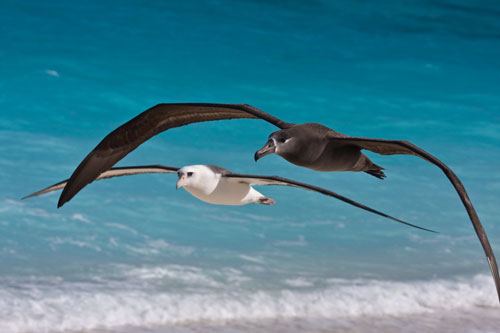Since ACAP's beginnings, the United States has expressed a keen interest in the Agreement's activities. US federal managers have actively participated in ACAP meetings from the start. For example, the ACAP Seabird Bycatch Working Group has included Kim Rivera of the US National Oceanic and Atmospheric Administration (NOAA) Fisheries as an invited expert since the group was formed, and Nicole LeBoeuf, also now of NOAA Fisheries, was seconded to the ACAP Secretariat in 2006/2007.
Joining an international treaty is no simple feat for any country. For over three years, staff members within US federal agencies have worked with bird conservation NGOs and the US Congress to join ACAP. The Bush Administration expressed interest in acceding to the Agreement, given the fond memories of former First Lady Laura Bush of walking among albatrosses on Midway Island in the North Pacific and due to the President's overall interest in bird conservation. In September 2008, the US State Department submitted ACAP to the US Senate committee which decides on the United States joining international treaties, asking for its consideration of the Agreement. Then, on his last day in office, President George Bush forwarded to Congress proposed legislation (click here) which would implement ACAP if the Senate approved acceding to the Agreement.
United States interest in joining ACAP became even more focused once ACAP Parties chose to list the three North Pacific Albatross species on Annex I of the Agreement in May 2009. Shortly thereafter, President Barack Obama announced his treaty priorities. The short list included ACAP. This announcement, coupled with the attendance of Dr. Jane Lubchenco, the head of NOAA, at a reception in Washington, DC (hosted by Prince Albert II of Monaco and BirdLife International, click here) in December 2009 signals continued interest by the United States in joining ACAP.

Staff from key US federal agencies also attended the reception, mingling with bird conservation groups and sharing their positive views on US involvement in ACAP. According to US officials, the next step in the United States joining ACAP will be for a member of the US Congress to introduce legislation to implement ACAP. This legislation will most likely be patterned after the Bush Administration's proposed bill. Once advanced through the political process, the bill can be attached to the existing request with the US Senate to consider joining the Agreement. In the meantime, US federal agencies with responsibility for seabird conservation continue to work together and with conservation NGOs and lawmakers on Capitol Hill to determine how best to implement the treaty, including by providing technical drafting assistance and other expert input to interested members of Congress.
In addition to its interest in joining ACAP, the United States continues to take a leadership role in seeking binding measures for reducing seabird bycatch within the Regional Fisheries Management Bodies. Related to this, the United States is co-hosting an important upcoming joint meeting of the five tuna RFMOs in Brisbane, Australia in June 2010. Given its expert role in global seabird conservation, ACAP's advice and input will be sought in the planning and execution of the meeting. More information on this meeting can be found at: www.tuna-org.org.
Click here for an earlier news item on USA acceding to ACAP.
News from the United States, 24 February 2010

 Français
Français  English
English  Español
Español